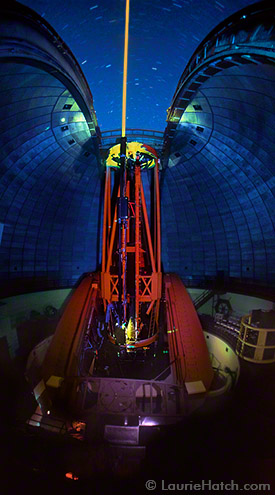Adaptive Optics at Lick Observatory

AO Imaging at Lick Observatory
AO has enabled atmospheric observations of planets and satellites within our solar system. Examples include Neptune's weather and the atmosphere of Titan.
Extremely clear observations of asteroids indicate that some asteroids are actually double. With AO, these objects are resolved into two separate images.
Active galaxies have black holes in their centers that are actively consuming
gases and emitting x-rays. Lick astronomers study two types of active galaxies
using AO:
- Quasars are very distant and massive active galaxies that emit visible light, x-rays and radio waves. Using AO, researchers now observe quasar spectra.
- Seyfert galaxies visible and infrared light, x-rays, and radio waves. Through direct imaging, AO is beginning to reveal the inner environment adjacent to the black hole, as well as the surrounding galaxtic structure.
What is Adaptive Optics?
Adaptive optics (AO) is an enormous new area of interest throughout the world, and includes both instrumentation and observation. AO provides a clearer view of the universe by compensating for atmospheric turbulence that causes stars to "twinkle."
The adaptive optics adjustment is made with a deformable mirror that is almost infinitely adjustable. It changes shape in numerous places hundreds of times per second, compensating for changing atmospheric conditions to focus light precisely.
Essentially, when a celestial object is to be observed, a fairly bright star nearby is monitored, and a correction is made for the "twinkle" that is observed. This correction is then applied to the object when it is observed.
Lick Laser Guide Star System
A natural guide star is not always present near the object to be observed. Lick Observatory astronomers and scientists from Lawrence Livermore National Labs engineered the world’s first laser guide star system routinely used for science. By shooting a laser beam into the sky near the object to be observed, astronomers create an artificial "star" of glowing atmospheric sodium ions. This laser guide star functions like a natural guide star, providing correct focus for the object being observed.
AO Now & in the Future
AO is currently used to image astronomical objects using the highly specialized IRCAL infrared camera built by UC Berkeley Professor James Graham and his students. AO spectroscopy is emerging, and will be used to see spectra of small regions of distant galaxies. Infrared AO observing is another exciting new field. AO now provides improved image focus for IR imaging.
The Center for Adaptive Optics
The Center for Adaptive Optics, located on the UC Santa Cruz campus, is dedicated to the development of AO for astronomical, medical and industrial applications. Funded by the National Science Foundation (NSF), CfAO provides collaborative workspace and information for numerous affiliated educational and business institutions to expand the horizons of AO worldwide.